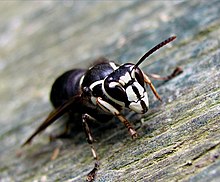Bald-faced hornet
| Bald-faced hornet | |
|---|---|
 |
|
| Scientific classification | |
| Kingdom: | Animalia |
| Phylum: | Arthropoda |
| Class: | Insecta |
| Order: | Hymenoptera |
| Family: | Vespidae |
| Genus: | Dolichovespula |
| Species: | D. maculata |
| Binomial name | |
|
Dolichovespula maculata (Linnaeus, 1763) |
|
| Synonyms | |
|
Vespa maculata |
|
Vespa maculata
Dolichovespula maculata is a eusocial wasp of the cosmopolitan family Vespidae. Its colloquial names include the bald-faced hornet, bald hornet, white-faced hornet, white-tailed hornet, blackjacket, and bull wasp. This species is a yellowjacket wasp, not a true hornet (genus Vespa). Colonies contain 400 to 700 workers, the largest recorded colony size in its genus, Dolichovespula. It builds a characteristic large hanging paper nest up to 58 centimetres (23 in) in length. Workers aggressively defend their nest by repeatedly stinging invaders.
Dolichovespula maculata is distributed throughout the United States and Southern Canada, but is most common in the southeastern United States. Males in this species are haploid and females are diploid. Worker females can therefore lay eggs which develop into males. Matricide might occur after sufficient workers have been raised and queen-destined eggs have been laid, in order to give workers a reproductive advantage.
The bald-faced hornet gets its name from the characteristic white markings on its face, as the word "bald" in English is derived from the word piebald. It was first described by Linnaeus in 1763. D. maculata is part of the cosmopolitan family Vespidae. It is in the genus Dolichovespula. Its black and white coloring differentiate it from its mostly black and yellow genus mates.
Baldfaced hornets are distinguished from other yellowjackets by their white and black coloring. It has a white or "baldfaced" head, which is the source of its colloquial namesake. These wasps also have three white stripes at the end of their bodies. They are notably larger than other species of Dolichovespula, as adults average about 19 millimetres (0.75 in) in length.Queen and worker wasps have similar morphologies. However, workers are covered by small hairs while the queen remains hairless. Queens are always larger than workers in their colonies, though size distributions can vary in different nests and workers in one colony might be as large as a queen in a different one.
...
Wikipedia
